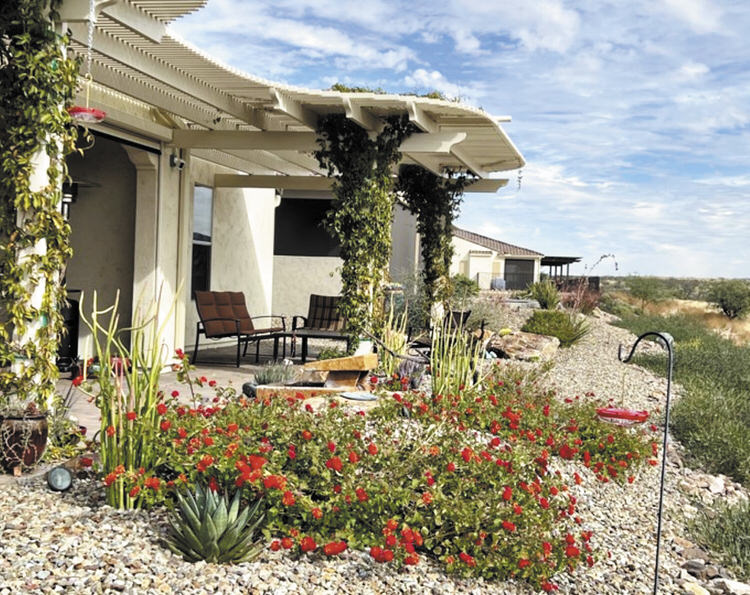
A male Anna’s hummingbird on a blue sage plant (photo by Jim Hoagland)

Hooded Oriole feasting on a crossvine in a backyard at the Ranch (photo by Jim Hoagland)

Backyard in the Ranch designed to attract birds and wildlife with plants and a fountain (photo by Jim Hoagland)
Jim Hoagland
Recently Kim Matsushino of the Tucson Audubon Society and I presented a program for the Master Gardeners at DesertView Performing Arts Center in SaddleBrooke. The topic was “Common Birds of Southeast Pinal County and How to Attract Them to Your Home’s Backyard.” There were more than 220 people in attendance, and you may have been one of them. If not, here is a summary of the presentation and how you might design your backyard at the Ranch to attract birds and other wildlife.
Since moving to the Ranch in June 2020, I have recorded more than 81 bird species in my backyard. There are 428 species that have been recorded in Pinal County and about 75 species are permanent residents. Of those species, about half are seen at the Ranch on a regular basis.
Our most common backyard birds here are the hummingbirds, a nectar-eating species. We have three permanent resident species, Anna’s, Broad-billed, and Costa’s hummingbirds. Some good native plants to attract them are chaparral sage, desert honeysuckle, hummingbird trumpet, Arizona yellow bells, desert willow, and milkweed. If you choose to use a feeder to attract hummingbirds, use a 4-part water to 1-part sugar mixture, and no red dye.
We also have several seed-eating bird species, including Lesser Goldfinch, Black-throated Sparrow, House Finch, Gambel’s Quail, and Lazuli Bunting. Some of the plants to attract these seed-eating birds are desert marigold, fragrant bee bush, flattop buckwheat, hopbush, and nature grasses such as blue grama, deergrass, and sideoats grama.
The next set of birds are insect-eating birds. If you want to attract these birds, you first need to have plants that attract insects, and then you may bet bird species that are attracted to those insects. Some good plants/trees for this are foothills palo verde, whitethorn acacia, and velvet mesquite. You can expect the following species to be attracted to those plants; Lucy’s Warbler, Abert’s Towhee, both Ash-throated and Brown-crested flycatchers, Vermilion Flycatcher, Phainopepla, and Western Tanager.
And the last set of bird species are fruit-eating birds such as Pyrrhuloxia, Northern Mockingbird, Northern Cardinal, and Gila Woodpecker. Plants good for attracting these species are ocotillo, gray thorn, desert hackberry, and wolfberry.
Plants not only provide food for bird species, but thick, thorny plants like prickly pear cactus provide nesting sites for species such as Gambel’s Quail, Greater Roadrunner, Cactus Wren, and Curved-billed Thrasher, as well as our hummingbirds.
Another key element for attracting birds to your backyard is water. A single water feature can provide much-needed relief to our birds, especially in the hot months of June, July, and August.
If you are interested in more information, check out “Habitat at Home” at TucsonAudubon.org/Habitat. They also have several “recipe” cards for inviting birds to your backyard.
You can also contact our local Southeast Pinal County Master Gardeners for additional help. They can be reached at planthelp@arizona.com. You will be surprised how easy it is to transform your backyard into a habitat that will enhance its beauty and restore bird and wildlife habitat.
